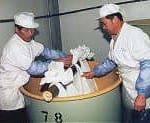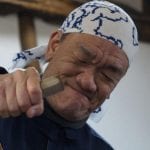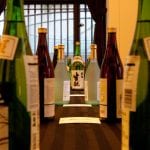 I have been hanging out with a lot of toji (master brewer) lately. No particular reason, just one tasting and event after another, interacting and listening to what they have to say. Here are a couple interesting anecdotes from a couple of interesting toji.
I have been hanging out with a lot of toji (master brewer) lately. No particular reason, just one tasting and event after another, interacting and listening to what they have to say. Here are a couple interesting anecdotes from a couple of interesting toji.
In June, at the Iida Sake Brewing Seminar about which I wrote last month, Philip Harper, the toji at Kinoshita Shuzo on Kyoto – brewers of Tamagawa sake – talked about his take on how to make good sake. Naturally enough, there was much talk of toji. While the term translates loosely as “master brewer,” there is a lot more to it. And what is “to it” has changed over the decades.
Long ago, the toji was responsible for not only brewing the sake, but hiring, firing, and buying the rice as well. The kuramoto, or brewery owner, gave him a chunk of change and left everything in his fine hands. These days, he or she might not do all of that, but in exchange has to keep in mind the larger picture of marketing, pricing, and product differentiation.
Limiting it just to technical stuff, though, the toji of today have all kinds of modern measurement equipment at their disposal. Scales, thermometers, sensors of all kinds, and computers to combine it into a useful form from which brewers can make decisions to precisely target what they want. It’s all pretty neat, really.
But long ago, there was none of that. Fingertips were thermometers, noses and tongues were hydrometers and alcohol sensors, and brushes and ink were the computers. Sounds pretty primitive, doesn’t it?
As a point in passing, Mr. Harper mentioned something that astounded me to hear. Curious researchers noted the measurements made within the brewing process, such as temperature and moisture and many other factors, by older toji who brewed without depending on modern tools, but instead their own five senses. And these were compared to those made with modern technology.
And guess what? Lo and behold, the measurements made by the tool-less toji relying o their senses were found to be within one percent of those made by modern technological tools. Within. One. Percent. And that shows the power of experience and intuition.
~~~~~~~~~~~~~
 Last month at a Hiroshima sake lecture and tasting, Tatsuya Ishikawa, the toji at the brewery making Taketsuru sake, presented his take on being a toji, and brewing local sake in Hiroshima.
Last month at a Hiroshima sake lecture and tasting, Tatsuya Ishikawa, the toji at the brewery making Taketsuru sake, presented his take on being a toji, and brewing local sake in Hiroshima.
He is a strong-willed yet light-hearted individual with well formed opinions on how sake should be brewed and the importance of regionality and terroir in sake brewing. And as one point in evidence, I was surprised to hear that he applies almost no temperature control at all to his fermenting tanks of sake.
While many – if not most – brewers will chill down tanks of fermenting ginjo to minimize bacterial havoc and promote cleaner flavors, Ishikawa Toji is having none of that. He lets it run at whatever the ambient temperature in the kura is, leading to his unique sake.
“If we are going to manipulate the environment and negate the effects of the climate,” he explains, “what is the point of making local Hiroshima sake?” Indeed, his strong feelings for tradition and it significance are clear. He continued by explaining that he cannot really get behind the concept of a toji that takes too much direction from the brewery owner. Long ago, the owner did not even enter into the brewery, much less suggest to the toji what sake to brew.
But these days, it is of course normal for the owner and the toji (when they are not the same person, which they often are these days) to discuss with each other what kind of sake to brew. Not this guy. It was part of his arrangement with his employer when he took over as toji. “I brew what I want, with no well-meaning direction or influence from you or anyone else.”
As I wrote about in this newsletter a few months ago, the old guilds’ significance is waning, and their influence is not at all what it used to be. Not that this is a completely negative thing; it is just the way things have become in response to the changes of modern times. But Ishikawa-san has his opinions.
“If the boss is going to direct everything about how the sake is brewed, what is the point of having a toji? Allowing such a situation to exist defeats the purpose of having a toji in the first place, and detracts from what terroir the sake might have.”
Certainly, both philosophies have their points. Much has changed, especially market realities and environments. And adapting to these is of utmost importance. But then again, so is maintaining the important and useful aspects of tradition.
In the end, the toji of olde and the toji of today each have had their unique set of circumstances and attendant challenges. It is not really fair or even possible to directly compare them. But it sure can be interesting to try!
Sake Professional Course
 The next Sake Professional Course will be held in Las Vegas, Nevada on November 27 to 29. Learn more here, and if you are interested in reserving a spot, please send me an email.
The next Sake Professional Course will be held in Las Vegas, Nevada on November 27 to 29. Learn more here, and if you are interested in reserving a spot, please send me an email.
The content of this intensive sake course will be identical to that of the Sake Professional Course held each January in Japan. The course is recognized by the Sake Education Council, and those that complete it will be qualified to take the exam for Certified Sake Specialist, which will be offered on the evening of the last day of the course.
Learn more about the course here. You can read Testimonials from past participants here.
If you would like to make a reservation or to be placed on the notification list, please send an email to that purport to sakeguy@gol.com.




